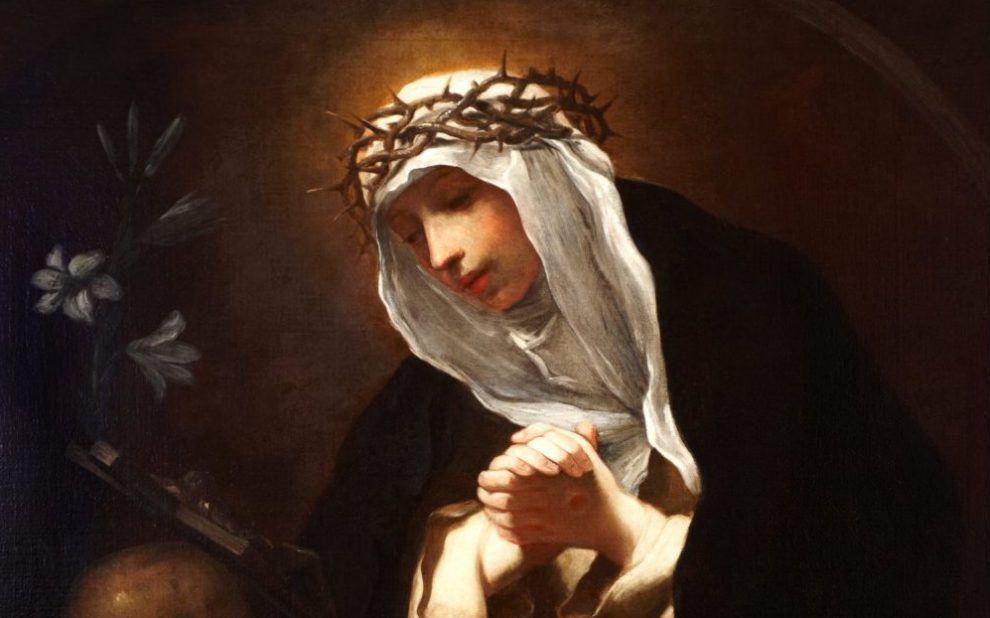I first met Caterina Benincasa, better known as St. Catherine of Siena, during a trip to her hometown in Italy. I was a college student trying to figure out how to become Catholic and still have a good relationship with my non-Christian family. I had spent that happy summer program in Florence studying Renaissance history, discovering the beauty of religious art, and falling in love with God.
I had read one of Catherine’s letters for a history class the year before, so I sort of knew who she was—a 14th-century lay Dominican mystic who had advised popes on church reform.
As I later discovered, she was born around 1347, right before the Black Death epidemic devastated Europe. Like most girls, she was uneducated and expected to accept an arranged marriage. Instead she became a third-order Dominican who lived an ascetic and contemplative life.
Called out of seclusion by God, she cared for the poor and the sick in her neighborhood and was known for her compassion and union with Jesus. But here’s the best part: She also became involved in city-wide mediation among warring factions and noble families bent on vendetta. She spoke out and sent letters imploring each side to understand the other and love like Christ.
In the last five years of her life, Catherine called for church reform and tried to restore the unity of the church torn by schism. She traveled to Avignon, France, the seat of the papacy at the time, to lobby Pope Gregory XI to return to Rome and make peace in Italy.
By the time she died in Rome in 1380, Catherine had dictated more than 400 letters and a major mystical and theological treatise. Catherine is interesting to me as a historian because she exemplifies the role that faithful lay women, even uneducated ones, could play in the church. But she is important to me for very personal reasons as well.
On my trip to Siena as a college student, a friend and I decided to go looking for Catherine’s family home. We went into the chapel that was built over what had been the garden behind the house. It was a cool, quiet, colorful place.
I knelt and talked to God: How can I convert to Catholicism and still be at peace with my family? I heard back: “Be not afraid. I will help you.”
I didn’t know then that these were the kind of compassionate and energizing words that Catherine had uttered to her friends. Or that these were the kind of words that the risen Jesus had spoken to his disciples.
I just knew somehow that I could trust God’s enormous goodness. There would be a way through my hopeless situation. After we walked back out into the sunlight, my life changed. I was baptized two years later, and I still am very much at peace with my family.
What I most admire about Catherine is the creative ways she found to embody the heart of Christ, which became real to me on that summer day in Siena. Though she was horrified by sin within herself and others, by poverty, war, and church schism, Catherine persevered in her efforts to find constructive solutions to these problems. The divine love manifested by Jesus dying on the cross for us was the source of her energy and hope, and she sought to teach others how to become “other Christs,” too.
For Catherine the key to spiritual growth is to cultivate deep gratitude for God’s love. If we nurture deep consciousness of God’s infinite love for us, we are rendered “apt,” or able to love. That is the essence of Christian conversion as Catherine understood and I have experienced.
As a historian, I’ve come to appreciate how well Catherine used her culture’s imagery to describe how all can be transformed into Christ by meditating on his Passion and death, and letting his love and lifeblood become their own.
Bathe, plunge, and drown in the blood of Christ, she exhorted some correspondents. Drink it, be filled with it, and become totally inebriated, she wrote others. Hide in the wound of Christ’s side, or suck on his breast. Walk in a fragrant garden watered in Christ’s blood. Let it excite you to be a more courageous knight to fight evil.
This shocking language reflects the fact that medieval piety was more rooted in suffering than our own, but its vividness can reawaken our imagination and connect us anew to the embodied God who gave us his life and showed us the way to love.
Catherine has taught me—both as a young woman contemplating conversion and as a Catholic facing everyday challenges—that loving others entails sacrifice but is ultimately life-giving and the source of real delight and joy.
She was just an uneducated lay woman, but Catherine of Siena was a gifted spiritual teacher during her life and a true Doctor of the Church for us today.
This article appeared in the August 2009 issue of U.S. Catholic (Vol. 74, No. 8, pages 47-48).
Image: Baldassare Franceschini, Saint Catherine of Siena, Public Domain













Add comment